ANATOMY and PHYSIOLOGY. Skeletal Tissue, The Skeleton, Joints.
Total Questions : 44
Showing 25 questions, Sign in for moreIdentify the anatomical movement illustrated below and state the joint involved (for example flexion of the knee joint).
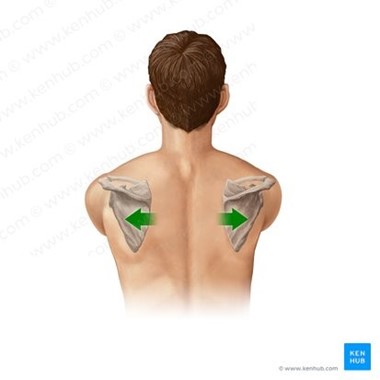
Explanation
Scapula protraction refers to the movement of the shoulder blade (scapula) away from the spine, toward the front of the body.
This movement is also known as scapular abduction or anterior scapular tilt.
The joint involved in scapula protraction is the scapulothoracic joint, which is not a true joint, but rather a functional joint formed by the articulation between the scapula and the thorax.
The scapula is a flat bone that glides over the back of the ribcage, allowing for a wide range of movements of the arm.
Other movements of the scapulothoracic joint include:
Scapula retraction: This refers to the movement of the shoulder blade towards the spine, away from the front of the body.
This movement is also known as scapular adduction or posterior scapular tilt.
Scapula elevation: This refers to the movement of the shoulder blade upwards towards the ears.
This movement is also known as the upward rotation of the scapula.
Scapula depression: This refers to the movement of the shoulder blade downwards towards the feet.
This movement is also known as a downward rotation of the scapula.
Scapula upward tilt: This refers to the movement of the upper border of the shoulder blade upwards, towards the head.
This movement is also known as superior scapular rotation.
Scapula downward tilt: This refers to the movement of the upper border of the shoulder blade downwards, towards the feet.
This movement is also known as inferior scapular rotation.
All of these movements are important for proper shoulder function and are necessary for a wide range of daily activities, such as reaching, lifting, pushing, and pulling.
Identify the anatomical movement illustrated below and state the joint involved (for example flexion of the knee joint).
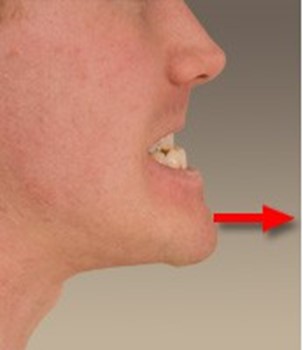
Explanation
Mandible protraction refers to the movement of the lower jaw (mandible) forwards, away from its rest position.
This movement is also known as jaw thrust.
The joint involved in mandible protraction is the temporomandibular joint (TMJ), which is a synovial joint that connects the mandible to the temporal bone of the skull.
This joint allows for a variety of movements, including:
Mandible retraction: This refers to the movement of the lower jaw backward, towards the skull.
Mandible elevation: This refers to the movement of the lower jaw upwards, towards the upper jaw.
Mandible depression: This refers to the movement of the lower jaw downwards, away from the upper jaw.
Mandible lateral excursion: This refers to the movement of the lower jaw to either the left or the right.
Mandible medial excursion: This refers to the movement of the lower jaw back to its midline position after a lateral excursion.
These movements of the TMJ are essential for functions such as chewing, speaking, and swallowing.
However, excessive or repetitive movements of the jaw can lead to TMJ disorders, which can cause pain, clicking, popping, or locking of the jaw.
Identify the anatomical movement illustrated below and state the joint involved (for example flexion of the knee joint).

Explanation
Radial flexion of the wrist, also known as radial deviation, refers to the movement of the wrist towards the radial (thumb) side of the forearm.
This movement is achieved by the contraction of muscles on the lateral (thumb) side of the forearm.
The joint involved in radial flexion of the wrist is the radiocarpal joint, which is a condyloid joint formed by the articulation between the distal end of the radius bone and the carpal bones of the wrist.
This joint allows for a range of movements, including:
1. Ulnar flexion of the wrist: This refers to the movement of the wrist towards the ulnar (little finger) side of the forearm, which is achieved by the contraction of muscles on the medial (little finger) side of the forearm.
2. Extension of the wrist: This refers to the movement of the wrist backward, away from the palm of the hand.
This movement is achieved by the contraction of muscles on the back of the forearm.
3. Flexion of the wrist: This refers to the movement of the wrist forwards, towards the palm of the hand.
This movement is achieved by the contraction of muscles on the front of the forearm.
4. Adduction of the wrist: This refers to the movement of the wrist towards the midline of the body, which is achieved by the contraction of muscles on the medial (little finger) side of the forearm.
5. Abduction of the wrist: This refers to the movement of the wrist away from the midline of the body, towards the radial (thumb) side of the forearm, which is achieved by the contraction of muscles on the lateral (thumb) side of the forearm.
All of these movements of the radiocarpal joint are important for fine motor skills, such as writing, typing, and playing musical instruments, as well as for everyday activities such as lifting and carrying objects.
Identify the anatomical movement illustrated below and state the joint involved (for example flexion of the knee joint).
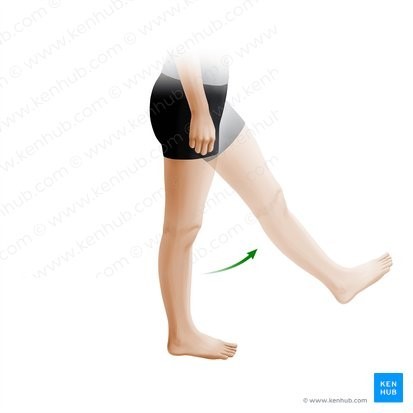
Explanation
Hip flexion refers to the movement of the thigh bone (femur) towards the front of the body, bringing the knee closer to the chest.
This movement is achieved by the contraction of muscles in the front of the hip, including the iliopsoas and rectus femoris muscles.
The joint involved in hip flexion is the hip joint, which is a ball-and-socket joint formed by the articulation between the head of the femur and the acetabulum of the pelvis.
This joint allows for a range of movements, including:
1. Hip extension: This refers to the movement of the thigh bone backwards, away from the front of the body, which is achieved by the contraction of muscles in the back of the hip, including the gluteus maximus and hamstrings.
2. Hip abduction: This refers to the movement of the thigh bone away from the midline of the body, towards the side, which is achieved by the contraction of muscles on the outside of the hip, including the gluteus medius and tensor fasciae latae.
3. Hip adduction: This refers to the movement of the thigh bone towards the midline of the body, which is achieved by the contraction of muscles on the inside of the hip, including the adductor muscles.
4. Hip external rotation: This refers to the movement of the thigh bone away from the midline of the body and outwards, which is achieved by the contraction of muscles on the back of the hip, including the piriformis and gemellus muscles.
5. Hip internal rotation: This refers to the movement of the thigh bone towards the midline of the body and inwards, which is achieved by the contraction of muscles on the inside of the hip, including the gluteus minimus and tensor fasciae latae.
All of these movements of the hip joint are important for walking, running, and other activities that require the use of the lower limbs.
Additionally, a lack of hip flexibility or strength can lead to compensatory movements in other parts of the body, which can result in pain or injury over time.
Identify the anatomical movement illustrated below and state the joint involved (for example flexion of the knee joint).
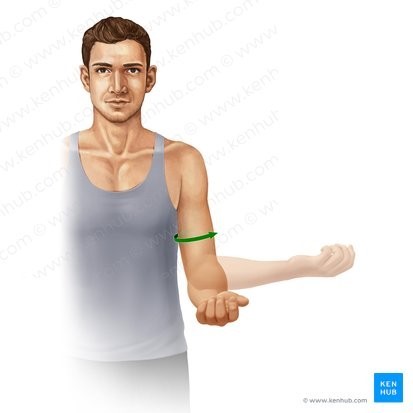
Explanation
External shoulder rotation is the movement of the humerus bone away from the centerline of the body, rotating the arm so that the palm faces away from the body.
This movement is achieved by the contraction of the external rotator muscles of the shoulder, which include the infraspinatus, teres minor, and posterior fibers of the deltoid muscle.
The joint involved in external shoulder rotation is the glenohumeral joint, also known as the shoulder joint.
The shoulder joint is a ball-and-socket joint formed by the articulation between the head of the humerus bone and the glenoid cavity of the scapula bone.
This joint allows for a range of movements, including:
1. Internal shoulder rotation: This is the opposite movement of external rotation, in which the humerus bone rotates inward toward the centerline of the body, with the palm facing inward.
2. Shoulder flexion: This is the movement of the humerus bone forward and upward, bringing the arm closer to the body's front.
3. Shoulder extension: This is the movement of the humerus bone backward and downward, moving the arm away from the body's front.
4. Shoulder abduction: This is the movement of the humerus bone away from the body's midline, raising the arm out to the side.
5. Shoulder adduction: This is the movement of the humerus bone toward the body's midline, bringing the arm back down to the side of the body.
6. Shoulder horizontal abduction: This is the movement of the humerus bone away from the body's midline at shoulder height.
7. Shoulder horizontal adduction: This is the movement of the humerus bone toward the body's midline at shoulder height.
All of these movements of the glenohumeral joint are important for many daily activities, including reaching, throwing, pushing, pulling, and lifting.
Identify the bone in the diagram below
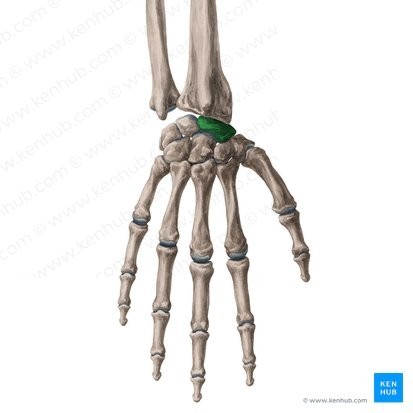
Explanation

The carpal bones, also known as the wrist bones, are a group of eight small bones located in the wrist joint.
They are arranged in two rows of four bones each, with the rows separated by a space known as the carpal tunnel.
The carpal bones are held together by ligaments, and their shape and arrangement allow for a wide range of wrist movements.
The names of the carpal bones, from the proximal row to the distal row, are the scaphoid, lunate, triquetrum, and pisiform, and the trapezium, trapezoid, capitate, and hamate.
Each bone has a unique shape and surface features that allow it to articulate with adjacent bones, forming a complex network of joints that are important for wrist and hand movements.
The carpal bones are important because they provide stability to the wrist joint, allowing for precise movements of the hand and fingers.
They also help to transfer forces from the hand to the forearm, and vice versa.
Injuries to the carpal bones can result in wrist pain, instability, and decreased function of the hand and fingers.
Additionally, the arrangement of the carpal bones can affect the function of the median nerve, which runs through the carpal tunnel.
Compression or irritation of this nerve can result in carpal tunnel syndrome, a condition characterized by pain, numbness, and tingling in the hand and fingers.
Identify the bone in the diagram below
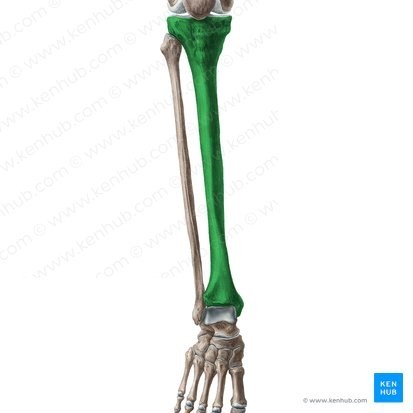
Explanation
The tibia, also known as the shinbone, is the larger of the two bones in the lower leg.
It is a long bone that extends from the knee joint to the ankle joint, and it plays an important role in supporting body weight and providing attachment sites for muscles.
The tibia has a triangular cross-section and features several surface landmarks, including the tibial plateau, the medial malleolus, and the tibial tuberosity.
The bone is also involved in the formation of the knee joint and the ankle joint, where it articulates with the femur and the talus bones, respectively.
Identify the bone in the diagram below
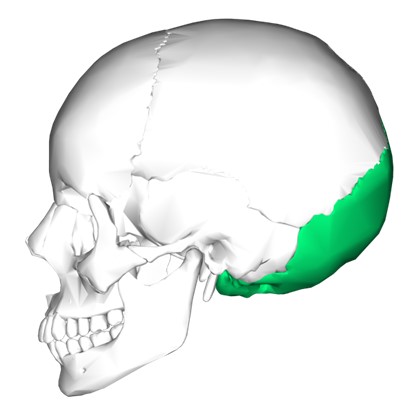
Explanation

The occipital bone is a flat, unpaired bone located at the posterior aspect of the skull, forming the lower part of the back of the head.
It features several surface landmarks, including the external occipital protuberance, which serves as an attachment site for muscles and ligaments.
The occipital bone also contains several foramina, including the foramen magnum, which allows the spinal cord to pass through and connect to the brain.
The occipital bone is an important site for the attachment of muscles involved in head movement and posture.
Identify the structure in the diagram below
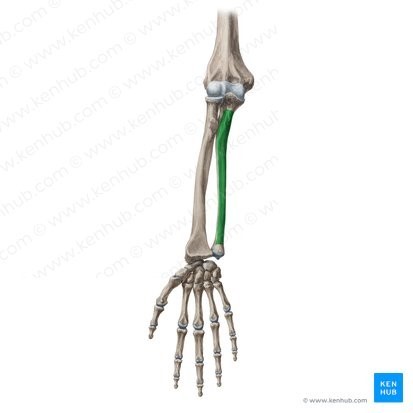
Explanation
The ulna is one of the two bones of the forearm, located on the medial (inner) side of the arm.
It is a long bone that runs parallel to the radius bone, extending from the elbow joint to the wrist joint.
The ulna features several surface landmarks, including the olecranon process, which forms the bony tip of the elbow.
The bone is also involved in the formation of the elbow joint, where it articulates with the humerus bone, and the wrist joint, where it articulates with the radius bone and several carpal bones.
The ulna is an important site for the attachment of muscles involved in forearm and wrist movements.
Identify the structure in the diagram below

Explanation
The posterior sacral foramina are openings located on the posterior aspect of the sacrum bone, which is part of the pelvis.
They are paired structures that allow the sacral nerves and blood vessels to pass through and exit the sacrum.
There are typically four pairs of posterior sacral foramina, located at the lateral margins of the sacrum.
These foramina are important for the transmission of nerve signals and blood supply to the lower limbs and pelvic organs.
Identify the structure in the diagram below
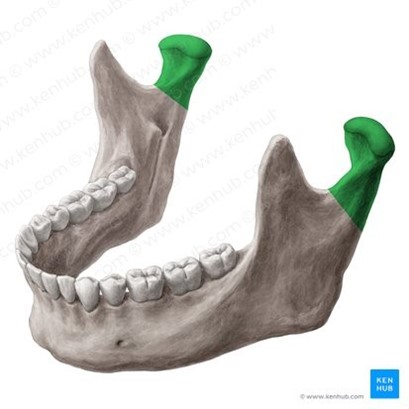
Explanation
The mandible condylar process is a bony projection located at the posterior aspect of the mandible, which is the lower jawbone.
It is a rounded, knob-like structure that articulates with the temporal bone of the skull, forming the temporomandibular joint (TMJ).
The condylar process allows for movements of the mandible, including opening and closing the mouth and chewing food.
The shape and position of the condylar process can affect the function of the TMJ and can contribute to conditions such as TMJ disorders.

Identify the structure in the diagram below
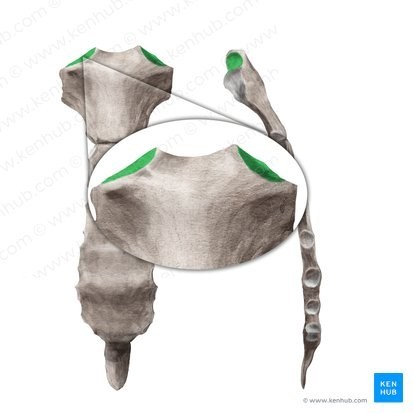
Explanation
The clavicular notch, also known as the sternal notch, is a shallow, V-shaped depression located at the superior aspect of the sternum, which is the long, flat bone in the center of the chest.
The clavicular notch serves as the articulation site for the medial end of the clavicle bone, forming the sternoclavicular joint.
This joint allows for movements of the clavicle and shoulder girdle, including elevation and depression of the shoulder and rotation of the scapula
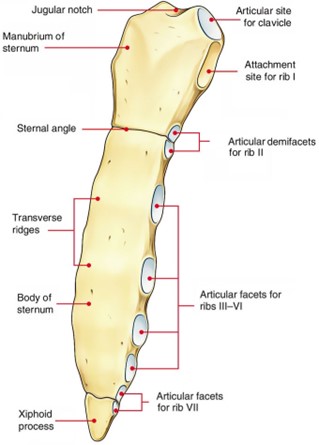 .
.
Identify the structure in the diagram below
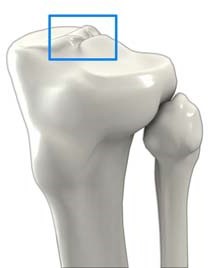
Explanation
The intercondylar eminence of the tibia is a prominent bony ridge located on the superior aspect of the tibial plateau, which is the top surface of the tibia bone that articulates with the femur.
The eminence separates the two condyles of the tibia and serves as an attachment site for several ligaments, including the anterior and posterior cruciate ligaments of the knee joint.
These ligaments play a critical role in stabilizing the knee joint and preventing excessive forward or backward movement of the tibia relative to the femur.
The intercondylar eminence also provides a surface for the menisci, which are C- shaped fibrocartilaginous structures that help absorb shock and distribute forces in the knee joint.

Identify the structure in the diagram below
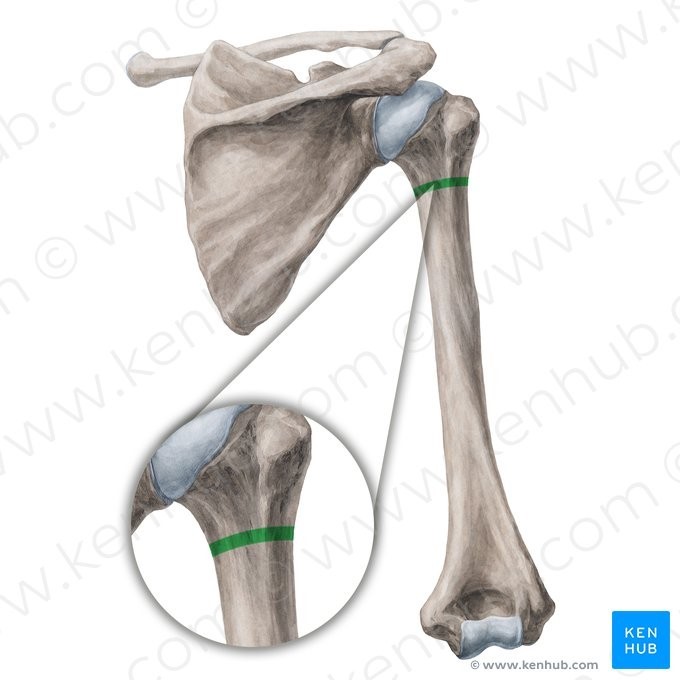
Explanation
The surgical neck of the humerus is a part of the bone that lies below the greater and lesser tubercles and is a common site for fractures.
It is the most constricted part of the humerus and marks the transition between the expanded proximal end and the narrower shaft.
The neck is located between the tuberosities and is the site of attachment for the capsule of the shoulder joint.
The axillary nerve and posterior circumflex humeral artery also pass through the surgical neck.
The anatomy of the surgical neck is important in the diagnosis and treatment of shoulder injuries and fractures.

Identify the structure in the diagram below
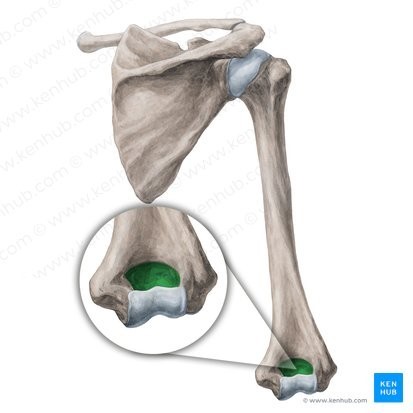
Explanation
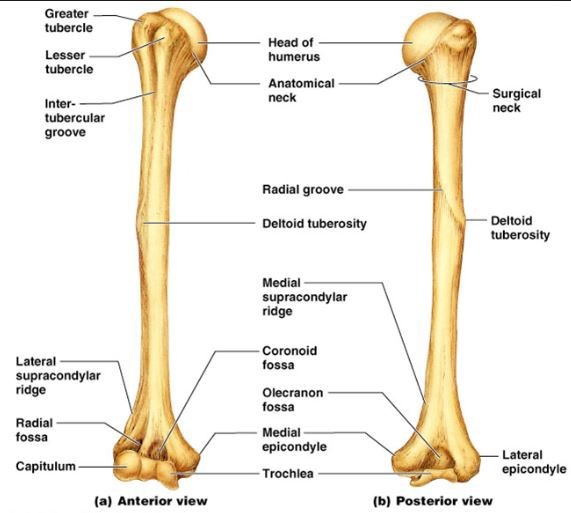
The olecranon fossa is a depression located on the posterior aspect of the distal end of the humerus bone, just above the trochlea.
It is part of the elbow joint and serves as a resting place for the olecranon process of the ulna bone during elbow extension.
The fossa is bordered by the medial and lateral epicondyles of the humerus and is separated from the trochlea by a thin medial ridge.
The olecranon fossa is an important landmark for orthopedic surgeons as it provides access to the distal humerus for surgical procedures, such as total elbow replacement.
Injury to the olecranon fossa can result in fractures or dislocations of the elbow joint.
Identify the structure in the diagram below

Explanation

The foramen transversarium is a canal that is found in the transverse process of the cervical vertebrae, C1 through C7.
It is an opening in the bone that allows the passage of the vertebral artery, vertebral vein, and sympathetic nerves.
The vertebral artery passes through the foramen transversarium in C1-C6 vertebrae, while the vertebral vein passes through the foramen in C1-C7 vertebrae.
The sympathetic nerves pass through the foramen in C1-C6 vertebrae as well.
Injuries to the foramen transversarium can cause damage to the vertebral artery and vein, leading to a variety of symptoms, including dizziness, headaches, and visual disturbances.
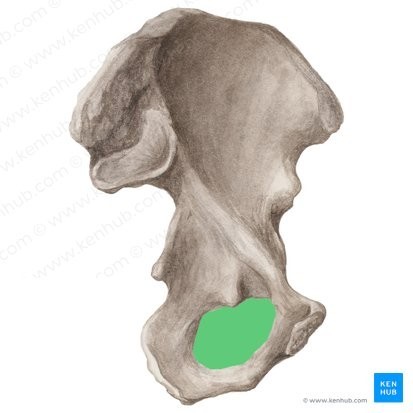 Identify the structure in the diagram below
Identify the structure in the diagram below
Explanation
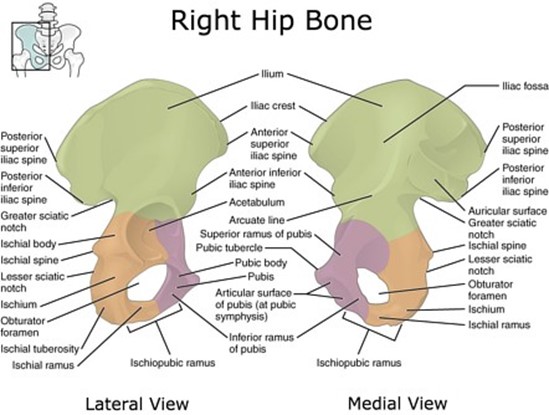
The obturator foramen is a large opening in the pelvis that is formed by the ischium and pubis bones.
It is located in the lower part of the pelvis, below the acetabulum (the socket of the hip joint).
The obturator foramen is covered by the obturator membrane, which separates the pelvic cavity from the thigh.
Several important structures pass through or around the obturator foramen, including the obturator nerve, artery, and vein.
Injuries to the obturator nerve can result in weakness or paralysis of the muscles of the inner thigh, while injuries to the obturator artery and vein can result in severe bleeding and require immediate medical attention.
Identify the structure in the diagram below
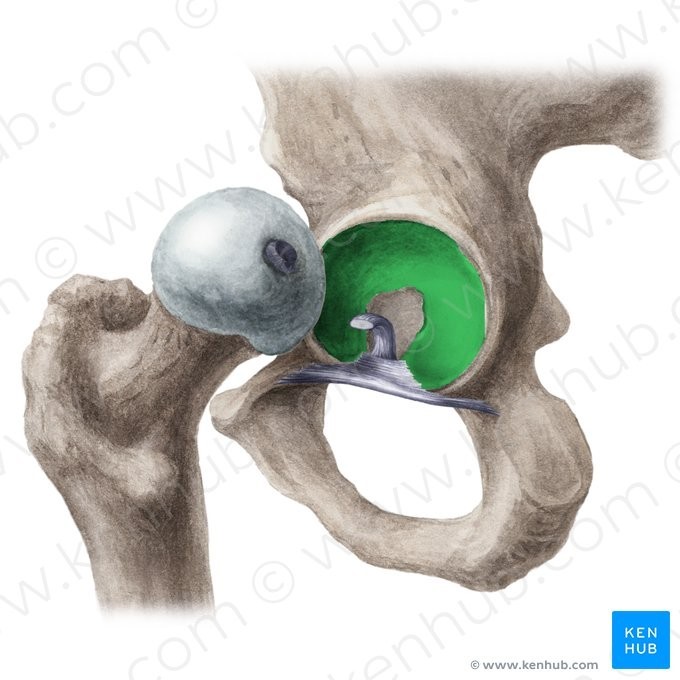
Explanation

acetabulum is the concave cavity located on the lateral surface of the hip bone.
It is formed by the fusion of the ilium, ischium, and pubis bones.
The acetabulum articulates with the head of the femur to form the hip joint, which is a ball-and-socket joint that allows for a wide range of movement.
The acetabulum is lined with articular cartilage, which provides a smooth surface for the head of the femur to move against.
The acetabulum is also surrounded by a fibrocartilaginous ring called the acetabular labrum, which deepens the socket and helps to stabilize the hip joint.
Injuries to the acetabulum can result in hip dislocations or fractures, which can be very painful and require medical intervention.
Identify the structure in the diagram below

Explanation

The ischial tuberosity is a bony prominence located at the base of the pelvis.
It is the part of the pelvis that bears weight when sitting and is commonly referred to as the "sitting bone." The ischial tuberosity is attached to several important muscles, including the hamstrings and the adductor magnus, which play a crucial role in hip extension and thigh adduction, respectively.
The ischial tuberosity is also an important landmark for identifying the sciatic nerve, which runs in close proximity to the bone.
Injuries to the ischial tuberosity can occur as a result of prolonged sitting, direct trauma, or repetitive stress, and can cause pain and discomfort in the buttocks and hips.
Identify the structure in the diagram below
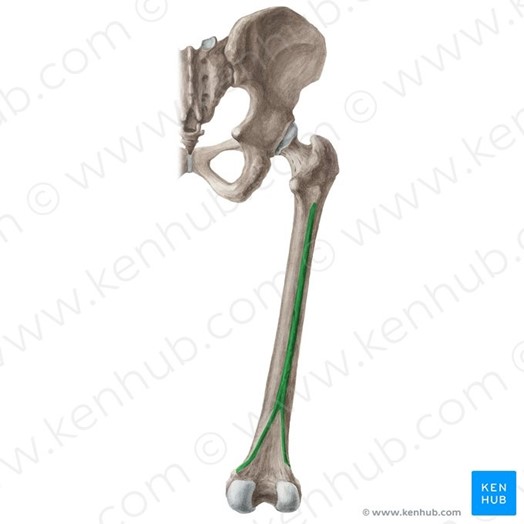
Explanation

The linea aspera is a ridge of bone on the posterior surface of the femur.
It is a prominent feature that serves as a site of attachment for several important muscles, including the adductor magnus, vastus medialis, and the long head of the biceps femoris.
The linea aspera extends from the greater trochanter of the femur to the lateral condyle of the femur, dividing the posterior surface of the bone into two distinct regions.
The medial lip of the linea aspera serves as an attachment site for the adductor magnus, while the lateral lip provides attachment for the vastus medialis and the long head of the biceps femoris.
Injuries to the linea aspera can occur as a result of direct trauma or repetitive stress and can cause pain and discomfort in the thigh.
Identify the structure in the diagram below

Explanation
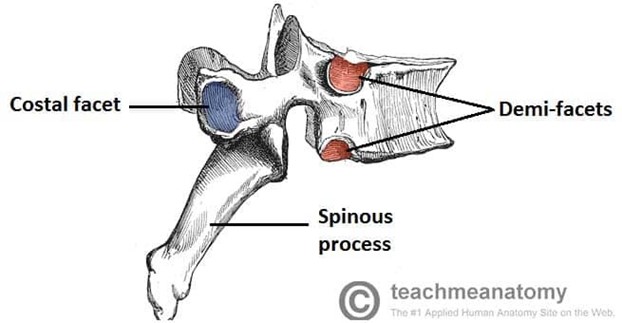
The thoracic costal facet is a feature found on the thoracic vertebrae, which are the bones that make up the mid-back region of the spine.
The costal facet is a small, flat surface located on the transverse process of the thoracic vertebrae, where it articulates with the head of the rib.
There are two costal facets on each thoracic vertebra, one on the transverse process and one on the body of the vertebra.
The costal facet is an important anatomical feature as it provides stability and support to the rib cage and facilitates the movements of the thoracic spine during respiration and other activities.
Injuries to the costal facet can result in rib fractures or dislocations, which can be very painful and require medical intervention.
Identify the structure in the diagram below
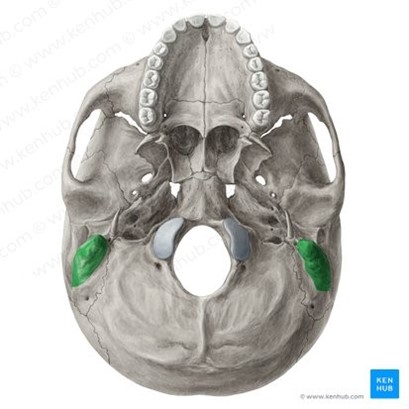
Explanation
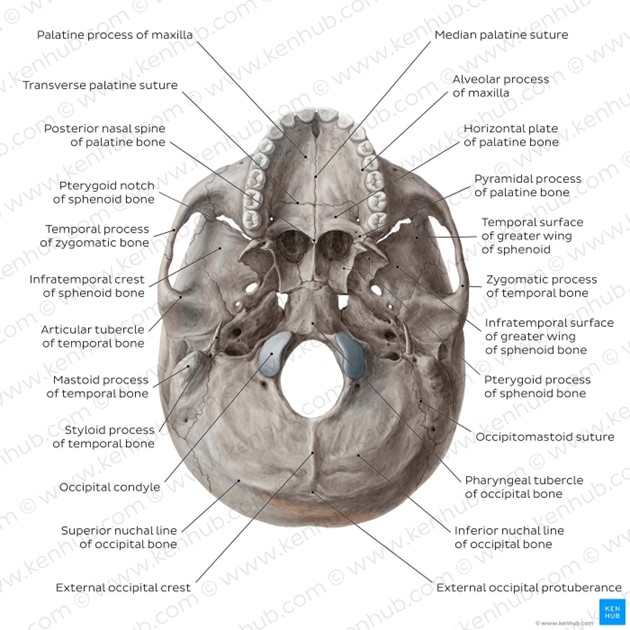
The mastoid process is a bony prominence located on the temporal bone of the skull, behind the ear.
It serves as an attachment site for several muscles, including the sternocleidomastoid and the splenius capitis.
The mastoid process also contains small air cells that are connected to the middle ear, which play a role in regulating the pressure within the ear.
In addition, the mastoid process is located in close proximity to several important structures, including the facial nerve, the internal jugular vein, and the sigmoid sinus.
Injuries to the mastoid process can occur as a result of trauma, infection, or tumors, and can cause pain, swelling, and other symptoms.
Which type of cell is responsible for breaking down bone tissue?
Explanation
Osteoclasts are the type of cells that break down bone tissue by secreting acid and enzymes.
They are derived from monocytes and macrophages, two types of white blood cells.
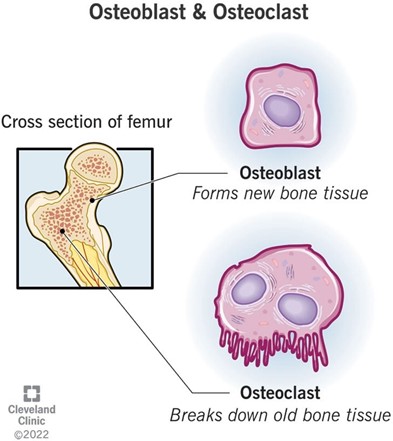
Choice B is incorrect because chondrocytes are the cells that produce and maintain cartilage, a flexible connective tissue found in joints.
Choice C is incorrect because osteocytes are the mature bone cells that maintain the mineral concentration of the bone matrix.
They are derived from osteoblasts, the bone-forming cells.
Choice D is incorrect because osteoblasts are the cells that form new bone by synthesizing and secreting collagen and calcium salts.
They are derived from osteogenic cells, the undifferentiated cells that can divide.
In what type of fracture do we consider the bone to be shattered?
Explanation
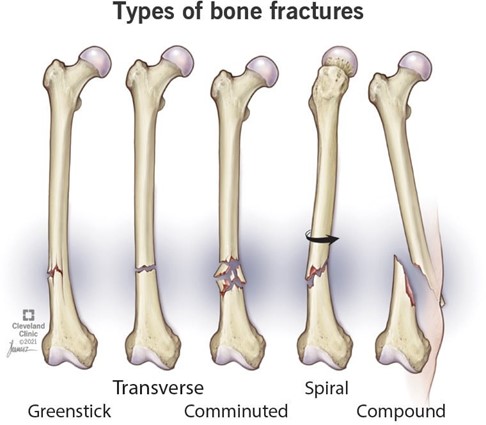
Choice A is incorrect because transverse fractures are the type of fractures where the bone has a horizontal fracture line.
They are usually caused by a strong force applied at a right angle to the bone shaft.
Choice B is incorrect because spiral fractures are the type of fractures where the bone has an angled fracture line that curves around the bone shaft.
They are usually caused by a twisting force applied to the bone.
Choice D is incorrect because greenstick fractures are the type of fractures where the bone is bent and partially broken on one side.
They are usually seen in children whose bones are softer and more flexible than adults.
Parathyroid hormone leads to an increase in blood calcium levels through increased activity in what cells?
Explanation
Osteoclasts are the type of cells that increase their activity in response to parathyroid hormone (PTH) and break down bone tissue to release calcium into the blood.
PTH helps maintain the right balance of calcium in the body by stimulating osteoclasts.
Choice A is incorrect because osteoblasts are the type of cells that form new bone tissue by depositing calcium into the bone matrix.
PTH inhibits osteoblasts and reduces bone formation.
Choice B is incorrect because canaliculi are not cells, but small channels within the bone matrix that allow osteocytes to communicate with each other and exchange nutrients and waste.
PTH does not affect canaliculi directly.
Choice D is incorrect because osteocytes are the type of cells that are mature bone cells trapped within the bone matrix.
PTH can stimulate osteocytes to release calcium from the bone, but not as much as osteoclasts.
Sign Up or Login to view all the 44 Questions on this Exam
Join over 100,000+ nursing students using Nursingprepexams’s science-backend flashcards, practice tests and expert solutions to improve their grades and reach their goals.
Sign Up Now

